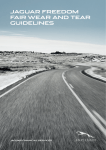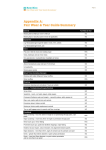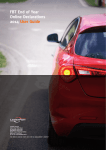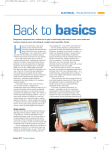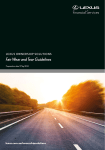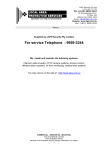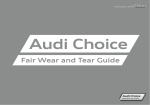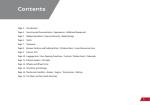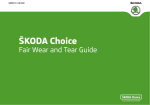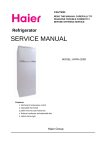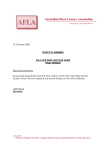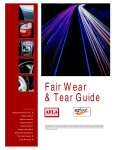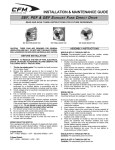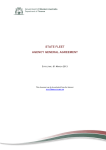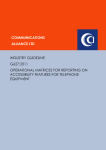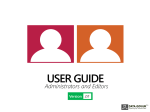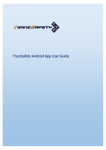Download Fair Wear & Tear Guide
Transcript
TOYOTA ACCESS Fair Wear and Tear Guidelines Preparation date: 1 February 2014 TOYOTA T OYOTA ACCESS A SMARTER WAY TO BUY toyota.com.au/access Important Notice These Fair Wear and Tear Guidelines are only applicable if you return your Vehicle on the expiry date. They are to be read with your Toyota Access Finance Contract. It is important that you are familiar with these Guidelines. They provide a basis for determining what is reasonable fair wear and tear for a vehicle at the end of your Finance Contract, based on the term and agreed number of kilometres (End Odometer), as set out in your Toyota Access Finance Contract. What is fair wear and tear? Fair wear and tear means: The deterioration in the repair, working order and appearance of your Vehicle, as is reasonably consistent with your obligations to use and maintain your Vehicle, in accordance with your Toyota Access Finance Contract and these Fair Wear and Tear Guidelines. —— Y our Toyota Access Finance Contract provides that you must keep your Vehicle in good order and repair. —— T hese Guidelines define the limits of acceptable damage and wear and provides clear examples of damage and wear that Toyota Finance will not accept as fair wear and tear. Why is fair wear and tear relevant to my Toyota Access Finance Contract? Toyota Finance has based the Guaranteed Future Value (GFV) for your Vehicle on being returned in good and proper working order (fair wear and tear excepted). It is also based on the number of kilometres that your Vehicle will travel over the contract term, i.e. the End Odometer. If your Vehicle is not returned to Toyota Finance in an acceptable condition, this results in the reduction in the GFV and the payment of a lesser amount – e.g. the Adjusted GFV. When will the assessment of fair wear and tear be made? Prior to the expiry date of your Contract, Toyota Finance will contact you to ask whether you are proposing to return your Vehicle on the expiry date in return for Toyota Finance paying you the GFV nominated in your Finance Schedule. Toyota Finance’s assessment will be based on the condition of your Vehicle at that time and whether it meets these Fair Wear and Tear Guidelines. Toyota Finance will also check the odometer to determine whether an Excess Usage Charge will apply. What happens if the Vehicle meets these Fair Wear and Tear Guidelines? If your Vehicle meets the Fair Wear and Tear Guidelines and has not travelled more kilometres than agreed, Toyota Finance will apply the GFV to your Finance Contract to meet your balloon final payment. What happens if the Vehicle does not meet the Fair Wear and Tear Guidelines? Where the Vehicle does not meet the Fair Wear and Tear Guidelines, Toyota Finance will reduce the GFV by the estimated cost of repairing or restoring the Vehicle to the condition it ought to have been at the end of the contract term. This reduced amount is called the Adjusted GFV and will not be sufficient to meet your balloon final payment obligation. How do you avoid a fair wear and tear adjustment being made to the GFV? i. K eep your Vehicle in good order and repair and ensure that it is regularly serviced in accordance with Toyota’s recommendations, as set out in the Toyota Service and Warranty Handbook. ii. Ensure that your Vehicle does not travel more than the agreed kilometres. Lack of regular servicing and attention to preventative measures, plus misuse or neglect, are the main reasons for vehicles not meeting these Fair Wear and Tear Guidelines. Some tips to ensure that your Vehicle meets the Fair Wear and Tear Guidelines —— E nsure your Vehicle is regularly serviced in accordance with Toyota’s recommendations – refer to your Toyota Service and Warranty Booklets. —— R egularly clean your Vehicle inside and out, including the upholstery and trim. —— R egularly check fluid levels and top them up when needed. —— I mmediately investigate any unusual mechanical noises or poor running symptoms – refer to your Toyota Dealer for assistance. —— F ix any damage or defects when they occur. —— E nsure that all controls are working. —— R egularly inspect your tyres and wheels to ensure that they are in good condition and safe. —— D o not exceed Toyota’s towing guidelines for your Vehicle. —— C omplete the Fair Wear and Tear Guidelines Checklist periodically and prior to the end of the contract term to avoid any surprises. Examples of fair wear and tear are provided on the following pages. For more information go to toyotafinance.com.au Toyota Access Fair Wear and Tear Guidelines These Guidelines are a guide to what is meant by fair wear and tear, which is the standard by which your Vehicle is to be assessed when it is returned to Toyota Finance relative to Vehicle type, age and distance travelled. Your obligations Maintenance – Regular maintenance and servicing should be carried out by your Toyota Dealer or by an authorised repairer in accordance with Toyota guidelines, using approved service parts and lubricants only. Any defects or damage that occurs during normal Vehicle use should be rectified as soon as possible. The Vehicle’s Toyota Service and Warranty Booklets (including the full service record) and any other documents relating to Vehicle equipment should be retained and made available if the Vehicle is to be returned to Toyota Finance at the end of the Contract period. All documents must be in the Vehicle upon return – including any details of radio codes. Appearance – The Vehicle should be returned at the end of the Contract period in a suitably clean condition to allow proper inspection of the paint, body and interior. Additional Equipment – Equipment such as car telephones that have been installed are to be removed, and any holes or damage should be repaired to a professional standard. All standard equipment, together with non-standard or ‘customised’ fittings originally supplied with the Vehicle, must be returned at the end of the Contract period. Badges and Labels – Non-standard badges, labels or advertising fitted to the body work or glass of the Vehicle should be removed, with any damage caused by their attachment or removal fixed. Any paint work colour fade due to the attachment of advertising would result in an adjustment to the GFV. Advertising should never be painted directly onto the Vehicle. Keys and Security – A full set of keys and remotes must be available and functioning. Return of the master key which controls the Vehicle’s engine management system is mandatory. If the Vehicle was originally supplied with a security system, this should be intact and fully operational, including any key or key fob necessary for operation. Any additional, non-standard security system should be fitted according to a recognised standard. Mechanical Condition – The Vehicle must be regularly serviced, properly maintained and kept in sound mechanical condition. The following examples are conditions usually caused by Vehicle neglect or misuse and therefore are not regarded as fair wear and tear. i.Brakes – Grooved brake discs caused by metal to metal contact. ii.Engine – Seized due to running Vehicle with insufficient coolant and lubricating oil and with broken internal components. iii.Transmission – Slipping, erratic gear changing, clutch slipping, noisy transmission or ineffective synchromesh. Examples of what is acceptable and unacceptable fair wear and tear These can vary between makes and models and are subject to change. For more information on fair wear and tear, go to toyotafinance.com.au Carpet, Upholstery, Seats, Roof Liner, Floor, Centre Console and Luggage Area Acceptable Unacceptable ✔The interior should be clean and tidy with no visible burns, tears or permanent staining to the seats, headlining or carpets. Wear and soiling through normal use is acceptable, as are any repairs that are not readily visible ✗Burns, singes, cuts, rips, holes, tears, visible repairs to seats/trim and controls ✔Normal odours, tobacco smells ✗Damage to seat structure ✔Fading caused by normal exposure to sunlight ✔Removable stains and singes (to size of 10mm diameter) that have not holed fabric material For light commercial vehicles it is recommended that a lining be fitted in the load area to prevent serious damage to the Vehicle’s interior, as excessive damage to this area is unacceptable. CIGARETTE BURNS & STAINS ✗Immovable stains e.g. permanent soiling to seats and carpet caused by things like abuse (such as oil, solvent, paint, grease, etc.) ✗Torn or split luggage area trim panels, lining and floor coverings ✗ Mismatched colours ✗Stitching that has come apart and needs to be repaired TORN UPHOLSTERY Dashboard, Fascia and Door Trims Acceptable Unacceptable ✔Moderate scratches/markings ✗Tears and splits in upholstery ✔ Repaired console holes ✗Burn marks such as cigarette holes in seats ✔Fading caused by normal exposure to sunlight ✔ Removable stains and scuffing ✗Holes or damage caused by fitting or removal of accessories (e.g. car phone) ✗Missing items/accessories (e.g. radio, ashtray, cup holder) or inferior quality replacement controls HOLES LEFT FROM INSTALLATION MISSING LID/COVER Bumpers and Mouldings Acceptable Unacceptable Provided these are not broken, cracked or deformed, a limited amount of scuffing and score marks is acceptable. ✗Broken/dented bumpers and mouldings (includes divots, gouging, cracks, holes, splits, rips and any distortion or twisting) Examples are: ✔Marks covering an area less than 10cm2 x 1mm deep ✔Dents covering an area less than 20cm2 and not more than 2mm deep and two per bar SCRATCHES & MARKS ✗Misalignment ✗Missing moulds, grilles, bumpers or mudflaps originally fitted to the Vehicle ✗ Excessive paint chips SPLIT BUMPER BAR Body Work Acceptable Unacceptable Any damage must be repaired when it occurs. All work should be completed to a professional standard, with any applicable anti-corrosion guarantees taken into consideration. ✗Prominent paint touch ups/major flaking Minor paint touch ups or minor flaking is acceptable. Minor dents are acceptable as long as the paint surface has not been penetrated so that bare metal is visible or corrosion has set in. Minor areas of stone chipping, bonnet, lower wheel guard, door edge chipping and light scratches are acceptable, relative to the Vehicle’s age and mileage, as long as they have not penetrated through to the base metal and caused corrosion. ✗ Exposed undercoat or metal ✗Hail damage, buckling, distortions, missing badges ✗Foreign matter etched into paintwork (e.g. bird/bat excrement) ✗Scrapes/deep scratches – more than 25mm in length and deep – more than two per panel ✗Dents greater than 20mm in diameter ✗ Misaligned panels ✗Unrepaired or poorly repaired aerial holes (or, where applicable, aerial must be left in place) ✗ Poor panel/paint repairs Examples are: ✗ Any rust ✔Scratches – if not through colour coating – no more than two per panel/nine per car and less than 25mm in length and shallow – excludes through to metal ✗Structurally damaged, bent/twisted holes and rust in cargo area ✔Stone chips – six chips per panel up to 3mm diameter ✔Dents – two per panel/eight per car at 20mm diameter by 2mm deep ✗Prominent areas of major stone chipping ✗Multiple dents occurring on a single panel (no matter how small) that requires repairing/replacing ✗Major abrasions more than 25mm, signs of constant use of automatic car wash ✗Damage caused to the vehicle due to the attachment or removal of decals/stickers EXPOSED METAL DENT Glass, Lights and Mirrors Acceptable Unacceptable ✔One or two scratches outside the driver’s line of sight with any repaired bullseyes accepted to a maximum size of 10mm. Effectively, the windscreen must be able to pass a roadworthy inspection ✗Badly scratched windscreens, breaks, cracks or repair discolouration which interferes with driver’s vision within swept area ✔All lamps must be operational. Minor scuff marks or scratches are acceptable ✗Damage to electronics in front or rear screens ✗Broken mirror glass, lights or surrounds ✗Any damage to lights and glass that would make them non-operational and fail any state roadworthy inspection CRACKED WINDSCREEN CRACKED LIGHT Underbody Acceptable Unacceptable ✔Underside: Minor dents and deformation, such as stone damage, is acceptable as long as it has not caused major corrosion ✗ Major impact damage ✔E xhaust System: The system should be properly suspended and in efficient working order, with no gas leaks or evidence of blowing from the exhaust system joints and in undamaged condition. (Any suspected impact damage should be investigated and dealt with professionally.) OIL LEAK ✗ Oil leaks ✗ Extensive rust/corrosion ✗Damaged exhaust system/exhaust leaks caused by such damage ✗ Poor repairs ✗Twisted, distorted or bent chassis ✗Any damage to underbody that would fail any state roadworthy inspection EXTENSIVE RUST /CORROSION Tyres (including spare), Alloy Wheels and Wheel Trim Acceptable ✔All four alloy wheels/wheel trims must be intact, with no more than minor scuffing due to everyday use. The spare wheel, jack and appropriate wheel tools must be stowed properly and be in good working order ✔Scrapes and scratches covering not more than 30% of the surface area ✔ Minor scuffing Unacceptable ✗Alloy wheels that have scrapes and scratches covering more than 40% of the surface area ✗Mismatched tyres and wheel trims ✗Unroadworthy tyres that do not meet any state roadworthy inspections (e.g. damage to sidewalls or tread caused by ‘kerbing’ or other heavy misuse) ✗Uneven tyre wear ✗Replacement tyres/wheels that do not meet manufacturer recommendations ✗Retreads ✗ Damaged/missing mudflaps ✗Missing spare wheel/tyre ✗Missing jack and any tools supplied at time of Vehicle delivery ✗Broken/cracked tyres and wheel rims DAMAGED ALLOY WHEELS MISSING HUBCAP Accessories and Equipment Acceptable Unacceptable ✔All original controls must be intact and operate correctly. If replacement has been necessary, (e.g. due to theft) then equipment of a similar value and specification, preferably of the same manufacture as the original, should be fitted ✗ Broken aerial ✔ Removal of any accessory fitted at the customer’s expense provided this does not cause damage to the Vehicle ✗ R emoval of accessories financed by Toyota Finance ✗Missing cigarette lighters, badges, knobs, trims, tools, jack, spare wheel, spare tyre, service books ✗ Missing keys and remotes ✗Missing Owner’s Manual and Service and Warranty Booklets ✗Information stored in GPS/Satellite Navigation Systems should be deleted MISSING ACCESSORIES (CIGARETTE LIGHTER, COIN TRAY, TRIM) MISSING ACCESSORIES (CIGARETTE LIGHTER, COIN TRAY, GEAR KNOB) Fair Wear and Tear Guidelines Checklist These descriptions relate to passenger vehicles and light commercial vehicles which have travelled less than 100,000 kilometres. Wear and tear commensurate with higher kilometres will generally apply. Fair Wear and Tear General —— M issing Service Manual, Owner’s Manual No —— M issing keys or security system remote (if applicable) No Equipment —— E .g. Missing/damaged cigarette lighter, knobs, trims, aerials No —— E.g. Missing/damaged tools, jack No —— Information stored in GPS/Satellite Navigation systems should be deleted Glass —— One or two minor chips, bullseyes and stars (not in field of vision) Yes —— Major chips, bullseyes and stars (and minor chips in field of vision) No —— Non-operational or cracked/broken headlights or lenses No Tyres —— Unroadworthy No —— Missing spare tyre No Wheel Trims (including hubcaps) —— M issing, split, badly disfigured, heavy scuffing No —— Minor scuffing Yes Interior – trim/upholstery/carpets/controls —— S crew holes from car phone removal No —— S eats/trim – burnt, cut, holed, ripped, visible repairs No —— S oiling to seats and carpets – caused by normal use Yes —— Permanent soiling to seats and carpets – caused by abuse, spills, grease, etc. No —— R ips, cuts, marks, splits to trim and controls No —— Normal odours, tobacco smells Yes —— M issing or inferior quality replacement controls No —— Torn or split luggage area trim panels and floor coverings No Paint/Body —— M inor scratching – less than 25mm in length and shallow, two per panel Yes —— Major scratching – more than 25mm in length and deep, more than two per panel No —— Minor touch ups or minor flaking Yes —— P rominent touch ups, spoils from bird/tree droppings, major flaking No —— Evidence of poor repairs, colour mismatch, misalignment between panels No —— Major abrasions – more than 25mm, signs of constant use of automatic car wash No —— Dents – greater than 20mm diameter or paint surface penetration No —— Dents – less than 20mm diameter, no paint surface penetration and no more than two per panel Yes —— Hail damage, buckling, distortion, missing badges No —— M inor stone chipping on bonnet, lower doors, wheel guards Yes —— P rominent areas of major stone chipping No —— Unrepaired or poorly repaired aerial holes (or aerial must be left in place) No —— Damage caused to the Vehicle due to the attachment or removal of decals/stickers No —— Damage to paintwork from bird and bat droppings No Mouldings/Grille/Bumpers/Mudflaps —— M inor parking damage – scuffing, light scratches Yes —— Medium damage – divots, gouging, minor dents, cracks No —— Major damage – rips, major dents, distortions, holes No —— M issing moulds, grilles, bumpers or mudflaps originally fitted to the Vehicle No Underbody —— Minor dents and deformations Yes —— Major impact damage No —— E xhaust leaks which are the result of visible damage to the exhaust system No Mechanical Condition —— Failure to service and maintain the Vehicle as per the manufacturer’s recommendations, resulting in premature component or assembly failure (e.g. engine seizure, metal to metal No brakes, transmission failure) Toyota Finance Locked Bag 900, Milsons Point NSW 1565 T 137 200 E [email protected] toyotafinance.com.au Toyota Finance is a division of Toyota Finance Australia Limited ABN 48 002 435 181, AFSL and Australian Credit Licence 392536. This guide has been prepared using the statement of the interpretation of Fair Wear and Tear Guidelines published by the Australian Fleet Lessors Association (AFLA). TFA037 D (04/2015)











